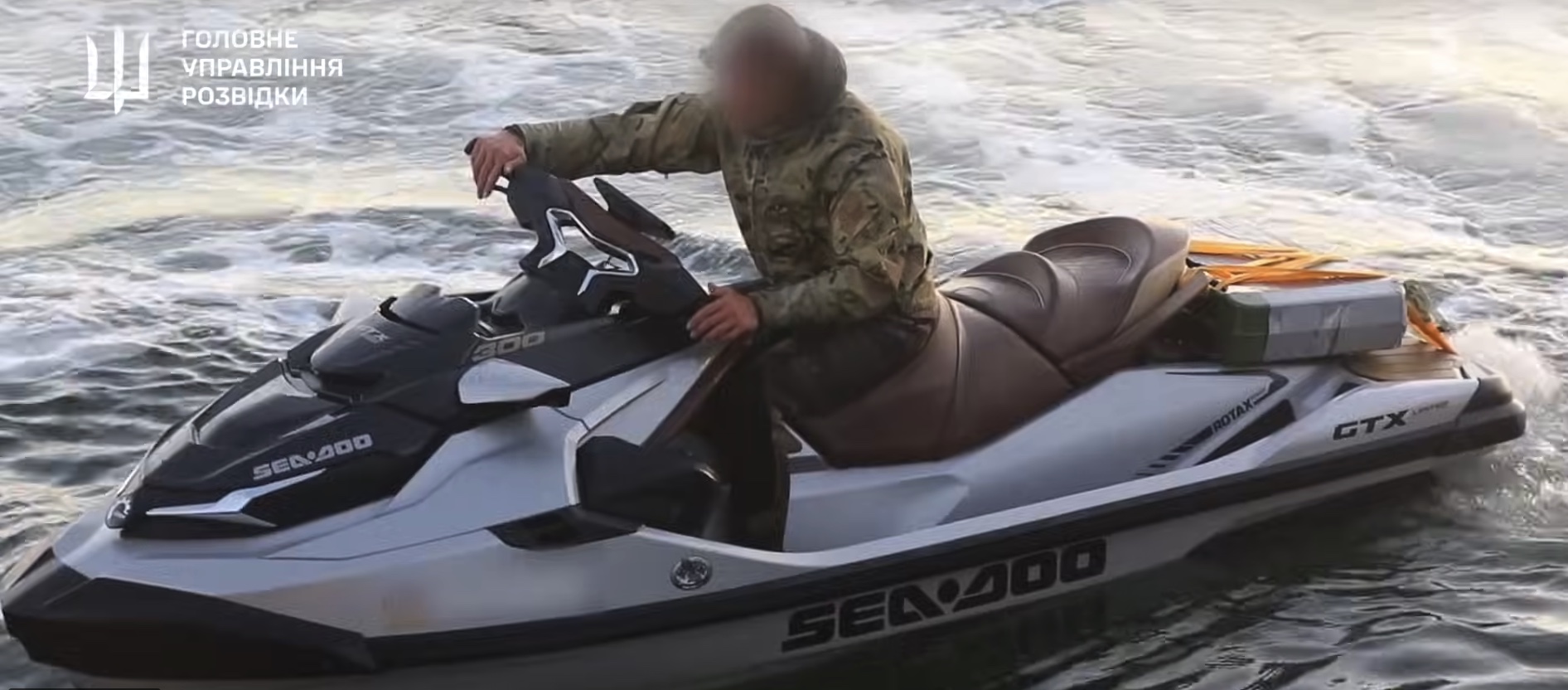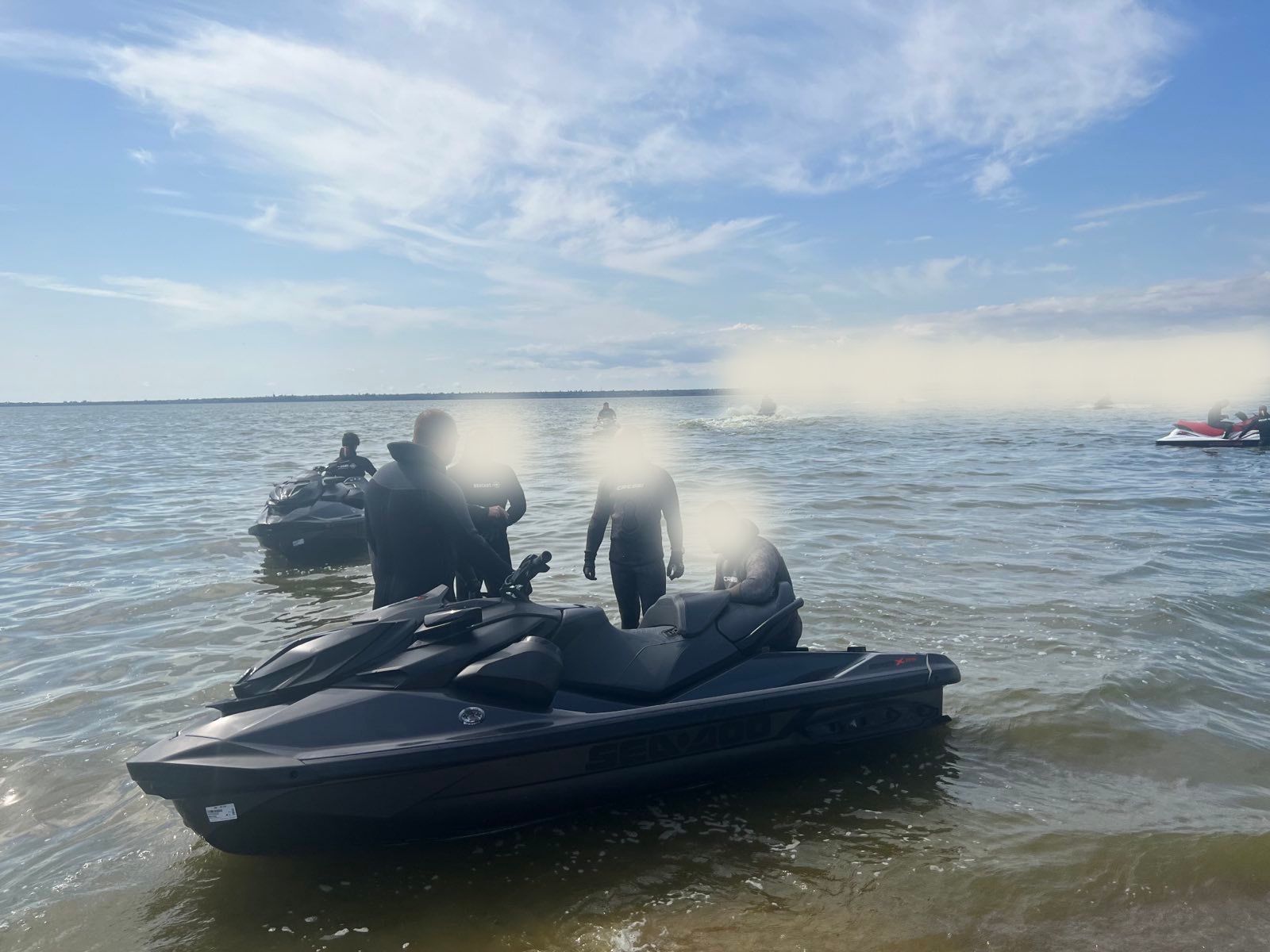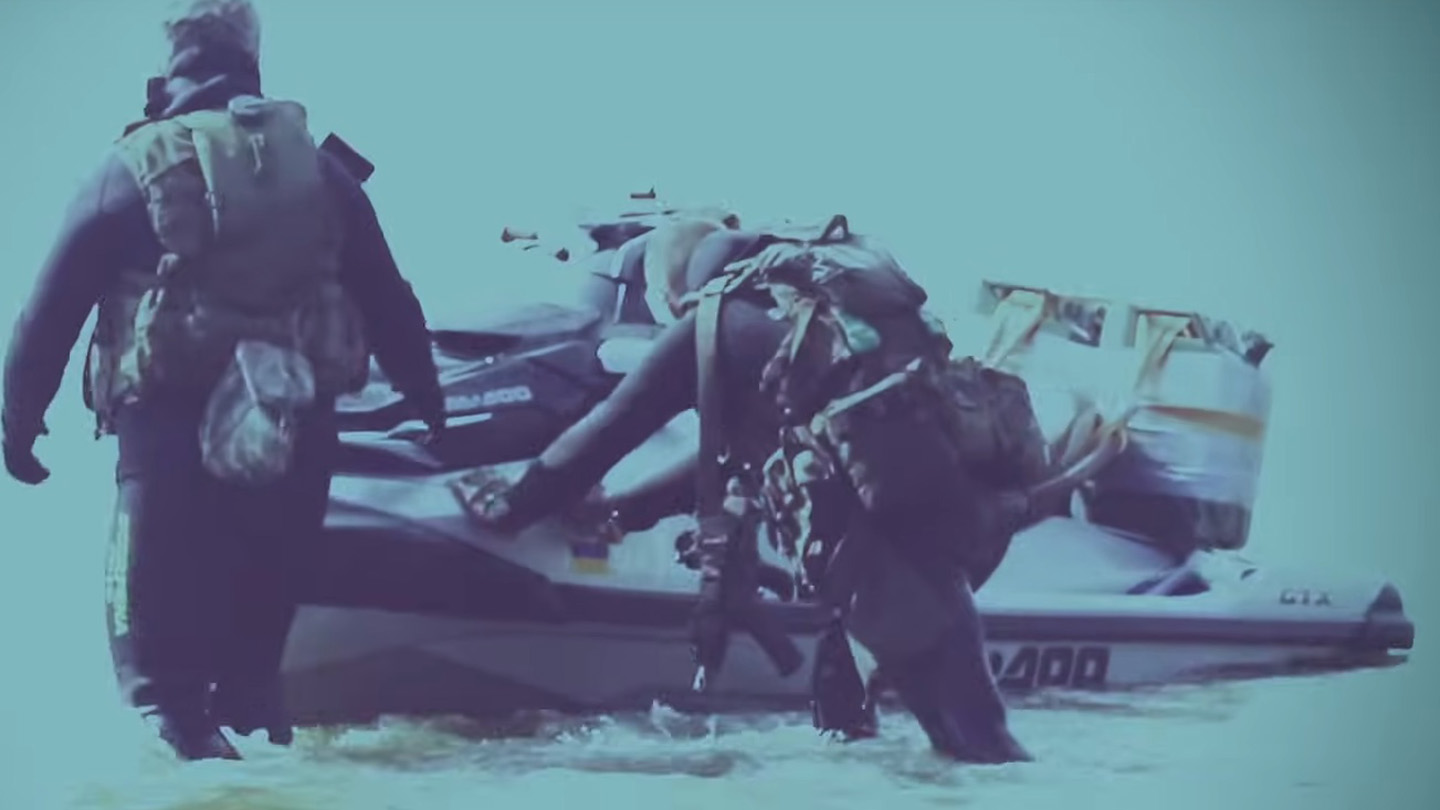The men of the Stugna unit were cold and tired as they approached the Crimean shoreline a little to the north of Tarkhankut Bay. The mission was a struggle even before they had to evade shore patrols, breach defensive lines and attack a building full of troops.
For 10 hours, they battled five-foot waves and chilly October water traversing the Black Sea on Sea-Doo GTX 300 personal watercraft. Loaded down by grenade launchers, machine guns, man-portable air defense systems (MANPADS) and other equipment needed to assault Russian positions, the watercraft frequently tipped over. That slowed the progression and increased the risk of detection as the Stugna raiders had to right the watercraft and make sure everyone was accounted for. The weather and harsh sea state weren’t the only concerns.
“We had a couple of minutes pause on our way when we came across two boats of our enemies,” Dmytro Linko, the commander of Stugna, – a special mission unit of the Ukrainian Defense Intelligence Directorate (GUR) – told The War Zone through an interpreter. “It was very hard.”
The raid was part of a much larger, ongoing effort, said Linko. He and two of his men who took part in the Oct. 4 mission and others agreed to provide us with exclusive insights into these operations.
“Strategically our objective is to liberate Crimea,” said Linko. “But tactically we have several goals. One is to actually eliminate as many enemies as is possible. And the other tactical objective is more of an ideological one. We need to show the resistance or the people in Crimea supporting Ukraine that we are moving forward and that the Ukrainian flag despite – being so many years out of Crimea – is back on the peninsula.”
Linko said the raiders selected the Sea-Doo personal watercraft for practical reasons.
“We had no other choice,” he said. “We used the ones we could find.”

Linko said the raids on Crimea and other targets in the Black Sea are a top priority of Lt. Gen. Kyrulo Budanov, commander of GUR. Budanov has frequently expressed his desire to us to see the peninsula liberated.
“We have been ordered to work on the de-occupation of Crimea,” said Linko.
Previous Experience Required
The men of Stugna have been fighting Russians for nearly a decade.
“We have been in this war from day one,” the Stugna unit commander told us, referring to the Russian invasion of the east and illegal annexation of Crimea in 2014.
One reason he and his men were chosen for these key assignments is their previous experience attacking Russian troops across the Dnipro River in occupied Kherson Oblast during the frigid month of January 2023. GUR posted a YouTube video of that operation, which you can see below.

“We were successful in those operations and that could have been one of the criteria to pick us,” said Linko.
One of those missions was against a Russian command center set up in a former restaurant near Khakovka. It was about two months after Ukraine recaptured Kherson City and six months before the nearby Nova Khakovka dam would be destroyed.
“We’d been given coordinates of the Russian command center by our aerial reconnaissance and the task destroy it,” said one of the Stuga members, who would only give his call sign, Vano, for operational security reasons.
“We were on four inflatable boats. And it was in the nighttime,” he said. “The problem we came across was a very dense mining of the bank of the river.”
“We knew the risks were high,” said Vano. “We tried to do our best to be as careful as possible. But since we had time limitations we had to take risks.”
Soon after reaching the shoreline, “we were met by the Russian machine guns,” said Vano. The raiders moved out toward the side of the building, away from the enfilade, fired their grenade launchers, tossed grenades by hand and destroyed the building, said Vano.

The mission was a success, but there was a price.
“We had some heavily wounded comrades but we didn’t have any lethal casualties,” said Vano. “We managed to give timely aid to the wounded colleagues.”
Those men have all since healed and are back in the fight, said Linko.
With the success of the Dnipro raids on their resume, the men were chosen to join Stugna. The unit was named after a river in the Kyiv region near where the unit first engaged in combat.
Boika Towers
As a precursor to raiding Crimea, the Stugna unit took part in missions to liberate Boika Towers, a cluster of highly important oil and gas drilling platforms in the northwestern Black Sea between Crimea and Snake Island. Though captured by Moscow in 2015, the towers were used for military purposes after the full-scale invasion, including as landing pads for helicopters and to station radio communications and surveillance equipment.
Linko explained for us his objective behind a mission captured in an official video released by Ukrainian military intelligence about the raid. It showed Ukrainian special forces aboard small, high-speed rigid-hull inflatable boats (RHIBs) racing toward one of the platforms, which you can see below.
The Stugna unit was tasked with de-mining the platform, said Linko.
“It was very hard because there was very dense mining and literally every door in the tower was booby-trapped,” he said.
It was a slow and laborious operation, but no one in his unit got hurt, said Linko.
Launched in the beginning of August and ending in the middle of September, the mission not only succeeded in liberating the towers, but Ukrainian forces found a number of “trophies,” said Linko.
In addition to yielding a stock of helicopter-launched rockets and an example of the Neva radar system used to track naval movements in the northwestern Black Sea, Ukraine found documents belonging to Russian commercial companies that have been stealing Ukrainian assets.
The Neva system, Linko added, is now being used by Ukraine to track the Russians.
Independence Day Raid
The first raid on Crimea was selected by Budanov with a very special date in mind – Aug. 24, the 32nd anniversary of Ukrainian independence.
“It was very symbolic,” said Linko.
Entering by small boat, the raiders landed on the shore, engaged Russians in combat, killed troops, destroyed equipment and planted the Ukrainian flag, the GUR said on its Telegram channel at the time. GUR produced a video of that raid, which you can see below.

Linko said the team Vano and Leo were on – one of many involved from across the Ukrainian military – played a supporting role in that operation.
“They were involved in the logistical part of that operation,” Linko said of his men. “There was a necessity to refill the fuel, to provide medical aid if necessary. To provide communications. To provide support when you have to deal with the Russian boats or aircraft.”
Aside from planting the flag on Crimea for the first time since 2014 and killing a number of Russians, the mission proved to be a learning experience for the raiders as well, said Linko.
“Practical experiences are very important,” said Linko. “It’s something which is very valuable for us to get because Ukraine had not performed such missions in the past, so we have to get this experience learn from it, and program our tactics.”

Ukraine in particular was trying to learn how the Russians patrol Crimea and how quickly they reacted to an incursion by sea.
“We tried to practically assess, based on our experience, the equipment and the technical things we need to take with us and to apply during such operations,” he said.
Ukraine also learned about the vulnerabilities of defenses on Crimea.
“There were extensive distances and they cannot physically cover every single gap,” said Linko. “That is why there are these gaps and we proved that it was possible to go on shore and perform such missions.”
Catching Russians Off-Guard
As they got closer to the Crimean shoreline in the overnight hours between Oct. 4 and Oct. 5, the Stugna team cut their engines and tried to stay silent and motionless as two Russian patrol boats passed by. Realizing they were unseen, the assault group “surfed past the boats and made it to shore,” said Linko.
The objective, he said, was a building along the Russian defensive lines.
“It wasn’t an important building but it was the building where the Russian troops lived,” he said.
Once ashore, Stugna engaged in a fierce and swift battle with the Russians, who opened up on the raiders with machine guns and assault rifles.
“The Russians were firing chaotically,” said Linko.
It remains unknown how many Russians were killed in that raid, said Linko, but he knows there were some.
“We fired grenade launchers at the building and destroyed it,” he said. “That’s why we’re sure they had casualties.”
The rapid nature of the raid took the Russians by surprise, allowing for a safe departure, said Linko.
“They panicked and didn’t manage to cling on to us as we were retreating,” he said.
Once out on the water, the assault party knew it was being chased as they made their way back across the Black Sea to the waiting support vessels.
“We could hear on the radio and see on the radar that the Russians were trying to find us with the use of aircraft,” he said. “But on this particular mission, they didn’t manage to find us.”
Despite a video that emerged on social media purporting to show the capture of one of the raiders, Linko would say only that no one in the Stugna unit was killed, wounded or captured.
Several Stugna unit members, however, did have to seek medical treatment after the mission.
“I lost five kilograms (about 11 pounds) as a result of this mission,” said Leo, one of the men on the mission speaking on condition that we only use his call sign. “Several of my colleagues lost considerable weight because it was a rather harsh physical experience.”
This won’t be the last such raid, said Linko.
“We are confident we are going to have more and more ambitious goals and objectives of our missions,” he said.
The recent hurricane-like storm in the Black Sea, which damaged Russian defenses, could very well aid future missions, a GUR official told The War Zone Wednesday. You can read more about some of that damage, to Sevastopol Harbor defenses, in our story here.
“A reduction in mines and beach fortifications could reduce some of the dangers these men face,” said the official, speaking on the condition of anonymity to discuss operational details.
We will be watching to see if Ukraine tries to take advantage of these new gaps in Russia’s defenses and how successful they are should that happen.
Contact the author: howard@thewarzone.com
